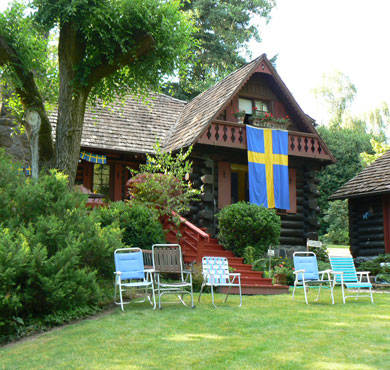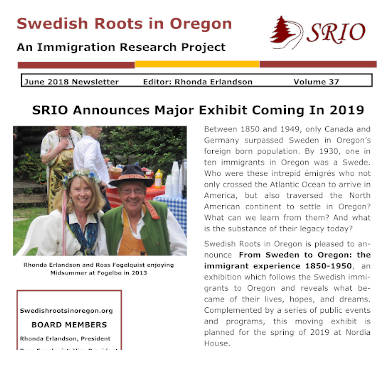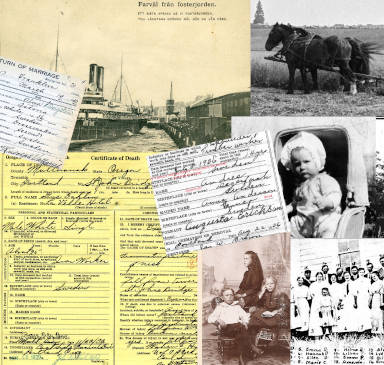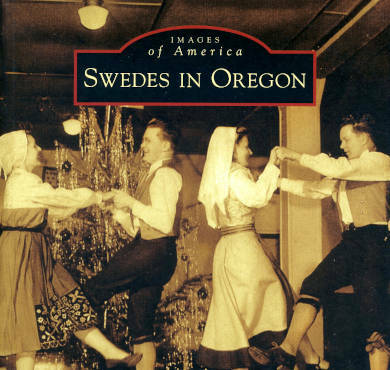Excerpt from the book Oregon och dess Svenska befolkning originally published in Swedish in Seattle, 1911.
Introduction to Oregon and its Swedish Population
by Ernst Skarstedt
“Oregon och dess Svenska Befolkning” was originally published in Swedish in Seattle 1911 (20 p.)
Ernst Skarstedt (1857 – 1929) had a privileged start in life, one that would have opened many doors for him: his father was a professor of theology at Lund, one of Sweden’s two old, prestigious universities, and his mother was the daughter of a famous churchman. But Ernst Skarstedt was a restless young man, an individualist, an independent thinker, not particularly religious, and not at all interested in following his father’s wishes for a Swedish university education. At an early age he was smitten by what was commonly referred to as “America fever,” and in 1878, at the peak of Swedish emigration to the United States, he joined in the exodus to the New World.
In the United States, Ernst Skarstedt soon became one of the most well-known Swedish-American newspapermen, working as an editor or contributor to many of the leading Swedish language newspapers in Chicago, San Francisco, and New York. A restless soul, a constant traveler, Ernst Skarstedt nevertheless dreamed of a rural way of life, and his editorial assignments were interspersed with attempts at farming in both California and Washington. He was an obsessive keeper of journals, documenting almost everything he saw or did. These journals would later serve as the source for many of his 13 books, all of which were written in Swedish, and almost all of which deal with the lives and activities of Swedes in North America.
After surviving the 1906 earthquake in San Francisco, but losing most of his books and papers in the conflagration that followed, Skarstedt relocated to the Seattle area and began work on an ambitious, three-volume history of the West Coast states. These books told not only the general history of California, Oregon, and Washington, but also carefully documented the Swedish presence there. The books were titled Washington och dess svenska befolkning (1908), California och dess svenska befolkning (1910), and Oregon och dess svenska befolkning (1911). All three volumes are organized in the same way: a series of introductory chapters describe the history, geography, agricultural and urban centers of each state. Following chapters portray Swedish life in America–settlements, churches, newspapers, and organizations. Finally each volume concludes with a large biographical section of prominent Swedes. At the time, the biographical section was probably the best way to create a market for these books, and today it has become a gold mine of genealogical information on the early Swedish immigration to the West Coast. Since Skarstedt occasionally worked as an itinerant photographer, all three volumes contain a great number of historical photographs of people and places.
The volume on the Swedes in Oregon is the slimmest of the three, and in the preface to the book Skarstedt complains that the interest and cooperation of his countrymen has been lukewarm at best. Still, it makes for some very interesting reading. What follows here is an excerpt from Oregon och dess svenska befolkning, chapters 10, 11, and 12, describing the life and activities of the Swedes in Oregon around the turn of the century.
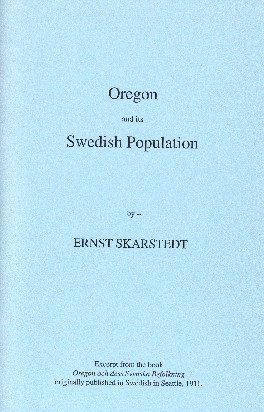
Excerpt from Oregon and its Swedish Population
by Ernst Skarstedt
Swedish Newspapers in Oregon
The first newspaper printed in the Swedish language in the state of Oregon was undoubtedly a Democrat campaign paper called “Demokraten” (The Democrat), published by the author of this book in Portland in May, 1890 during an unusually lively election campaign. Only two issues were published. The paper consisted of four pages with four columns per page. Its purpose was, according to the introductory announcement, to “help those readers who had not had the time or opportunity to become fully acquainted with the political circumstances out here, and who wished to make up their own minds independently.” The first issue was published on May 22, and the second on the 28th. The paper, which was paid for by the Democrat campaign fund, was distributed for free.
In June, 1892 three issues of a weekly paper called “Folkets Röst” (The Voice of the People) were published.
In 1894 another weekly called “Portlands Veckoblad” (The Portland Weekly) was published. It was started in April or May and continued until some time in December. J. L. Wallin and Edward Boyse collaborated as publishers and editors. Boyse wrote a light-hearted column in each issue under the pseudonym Anderson. This weekly had four pages with six columns per page.
In October, 1906 the first issue of an illustrated monthly called “Nordvestern” (The Northwest) was published. It was founded by J. L. Wallin with assistance from C. A. Appelgren and Ingemar Weström. The content mainly consisted of stories, and the illustrations primarily depicted landscapes from Oregon. Editorial essays were also published, occasionally written in rather strange Swedish. This publication folded in April, 1907.
In January, 1907 Pastor J. Ovall began publishing a “nonsectarian, religious newspaper” called “Härolden” (The Herald). During most of its existence it was normally published monthly and consisted of four pages with four columns per page. During the last two months it was published weekly and had changed its format to eight pages. It ceased publication in December, 1908.
During March and April, 1908 the typographer Oscar Hyllengren from Seattle published six issues of a six-page (initially four-page, but later eight-page) weekly called “Svenska Oregon-Posten” (The Swedish Oregon Post), which gained a fairly wide circulation, but which, however, was unable to stay afloat as long as the previously mentioned publications with the exception of “Demokraten” and “Folkets Röst.”
None of these papers met with a success that even came close to that of “Oregon-Posten” (The Oregon Post). The history of this paper is remarkable enough to deserve a more detailed description. On October 3, 1908, the newspaper man F. W. Lonegren traveled from Seattle, Washington to Portland with the purpose of starting a Swedish newspaper enterprise. Since all the Swedish newspapers published in Portland up to that point had, in terms of duration if not in other respects, disappointed the expectations of their readers, the skepticism toward Swedish papers was quite large. In spite of this, during a two week period, Mr. Lonegren successfully managed to convince about 20 Portland Swedes to sign up as share holders in the new newspaper company, and on November 9–to quote Mr. Lonegren– “the subscription for shares had proceeded so well that a decision was made to form a newspaper company called The Swedish Publ. and & Printing Co. and to incorporate it. The following were appointed incorporators: F. W. Lonegren, editor; W. Lidell, vice consul; C. J. Renhard, pastor; V. Brandt, hotel owner; Eric Helmer, merchant; and C. M. Anderson, restaurant owner. The first board of directors consisted of Samuel Holm, president; W. Sunden, vice president; E. Helmer, treasurer; F. W. Lonegren, secretary and manager; as well as Pastor C. J. Renhard; W. Lidell; and Alfred Anderson.” The number of shareholders was 30 at that time, but was later increased to almost 40. The paper was called “Oregon-Posten” and its first issue was published on December 2, 1908, with six columns and eight pages. The format was later increased to seven columns. F. W. Lonegren was appointed both editor and manager. From the start the paper gained a wide circulation, the equivalent of which has rarely been seen, at least on the West Coast. When the paper celebrated its first birthday, it surprised its shareholders by granting them a 10% discount on the price of a share. In June, 1910 the second large surprise came when the paper published a special edition totaling 32 pages with detailed descriptions of Oregon’s resources and geography; the history of the Swedish congregations, organizations and pioneer settlements, as well as the history of the entire state; stories; editorials; news; letters to the editor; and, last but not least, more than 200 portraits and other illustrations. “Oregon-Posten” is a political newspaper with strong leanings in the direction of the church and temperance movement. Its current board of directors consists of J. A. Backstrand, president; Pastor C. J. Renhard, vice-president; E. Helmer, treasurer; F. W. Lonegren, secretary and manager; as well as Alfred Anderson, C. J. Seaquest, and E. C. Johnson. The paper has correspondents in the Swedish communities in Oregon and receives weekly letters of events in Sweden from the editor’s sister Evelina Lonegren in Jönköping. The editor’s wife helps her husband in the editorial office; Andrew Johnson serves as the travel agent, and C. M. Newman is in charge of the printing office.
